In recent years, discussions about Skopje’s architecture have been largely pejorative, primarily dominated by the controversy surrounding the monuments and buildings springing up on both sides of the river around Macedonia Square, heavily influenced by political agendas. This does a grave injustice to the many master builders who have shaped this ancient city over the centuries.
Throughout its rich history, Skopje has served, among other roles, as the capital of both the Bulgarian and Serbian Empires and as the administrative centre of the Kosovo Vilayet – always at times when these were at the height of their power. As a result, it has become a place of longing, deeply mourned, a near-mythical city for the small, often divided nations of the Balkans. Skopje’s architectural heritage, however, is not as abundant as its history. A great fire and two devastating earthquakes have erased much of what once stood. Yet, fortunately, the most fascinating part of the city has been rebuilt after each catastrophe, allowing it to survive into the present day.
The Old Skopje Bazaar
A short walk from Macedonia Square, across the old Ottoman stone bridge, past the ever-present construction sites, and the atmosphere changes entirely. Fortunately, our generation still has the privilege of experiencing the authentic spirit of an old Balkan-Oriental bazaar.
The Old Skopje Bazaar (or Turkish Bazaar), with its winding streets lined with goldsmiths’, barbers’, kebab shops, teahouses, and other traditional trades, remains as vibrant today as it was three centuries ago. The scent of grilled ćevapi wafts through the air, impossible to resist. And somehow, just a hundred kilometres to the north, no one seems capable of preparing a shopska salad as delicious as the one found here.
A greeting in Turkish is common – much like in Prizren – though Albanian is frequently heard, with Macedonian being the most widely spoken language. Serbian is understood by practically everyone, and many also speak English. The use of Macedonian script in the bazaar is remarkably fluid: while official documents favour Cyrillic, Latin script is just as prevalent, sometimes following Serbian-Croatian orthography and at other times the Albanian spelling conventions – something rarely seen in other parts of Skopje.
Within the Old Bazaar lies the lively green market known as Bit Pazar (literally “flea market” in Turkish), a name that is sometimes used to refer to the entire Old Skopje Bazaar. The spontaneous urban development of the bazaar began in the 11th or 12th century, but its most significant and beautiful structures date back to the 15th century, and they have survived to this day in an authentic and well-preserved state. Among these historical landmarks are three caravanserais (that is, inns), two hammams (public baths), a bezistan (something like an early department store), as well as mosques and Orthodox churches – all testaments to the wealth, significance, and cultural depth of the city.
But for now, let’s turn our attention to Skopje’s old caravanserais.
The Standard Architecture of Caravanserais
A caravanserai (sarai = “palace” in Persian) is a traditional structure designed to provide rest for both travellers and their animals, built along the vast network of caravan routes that spanned three continents. Strategically placed roughly a day’s journey apart – even in the harshest deserts – these roadside inns ensured that caravans could always find shelter for the night, safe from the threat of highway robbers.
Caravanserais were constructed across a wide region, stretching from much of Asia to Southeast Europe and North Africa. Compared to their Western European counterparts of the same era, they offered a significantly higher standard of service to visiting merchants. The basic form of the caravanserai was developed in Persia around the 10th century and quickly became standardised across the lands where they were built, with only minor regional variations.
Typically, a caravanserai had a square layout with a large central courtyard, where horses and camels were housed. Its outer walls were fortified, built without openings to protect against bandits. There was usually a single entrance, positioned at the centre of one of the walls. The corners often included towers, and additional bastions could be found midway along the outer walls.
Around the courtyard, there were simple rooms for travellers, typically arranged on the ground floor and a single upper storey. Toilets were located within the corner towers, and a coveredarcadeusually separated the guest rooms from the courtyard. In Central Asian caravanserais, vaulted halls known as iwans – open on one side facing the courtyard – were often found at the midpoints of the inner walls. However, this architectural detail was uncommon in the Balkan caravanserais.
A typical caravanserai offered water and food for both people and animals, along with facilities for washing, resting, protection, preparation for religious rituals, and often the chance to engage in trade. Instead of the lengthy Persian-derived term caravanserai, the Ottomans preferred the word han, which was also adopted into Serbian, while in Macedonian, the term was simply “an.”
In Skopje’s Old Bazaar, three historic caravanserais still stand: Suli An, Kapan An, and Kuršumli An.
Suli An
The oldest of Skopje’s three caravanserais appears to be Suli An, dating back to the first half of the 15th century. Early records refer to it simply as the “old” han, while its later name, Suli (from the Turkish sulı, meaning “water”), reflects its original location beside the Serava River. This river once flowed along the eastern side of the han before merging with the Vardar in central Skopje.
Over time, as Skopje’s waterways were artificially redirected and modified, the Serava’s course was covered, and today, the river flows underground, beneath what is now Bitpazar Street.
Suli an
The oldest of the three khans of Skopje is, apparently, Suli an from the first half of the 15th century. In earlier writings it is mentioned as “old”, and later it was named Suli (suli=water, in Turkish). It got its name because it was located along the river Serava, which flowed along its eastern side and flowed into the Vardar in the center of Skopje. With the later artificial arrangement of watercourses, the river bed was covered, so the water now flows below the surface of the ground, and above it is today’s Bitpazarska street.

The anonymous architect of this structure largely adhered to the fundamental design principles of caravanserais, making only reasonable adaptations. Suli An was built on an approximately square base, each side measuring around 38 metres. Unlike some caravanserais, it lacks towers and bastions, and its traditional fortified outer wall is now partially obscured by a row of small shops built along its exterior, making it difficult to fully appreciate.
Suli An originally had two entrances – one from the main bazaar street on the western side, and another facing the Serava River on the eastern side. The structure consists of two levels with covered arcades surrounding a central courtyard. The ground floor contained 27 rooms: those on the northern side functioned as stables, while the others were used for storage. The upper floor housed 30 guest rooms, each equipped with a fireplace for heating. Built from stone and brick, Suli An features imposing arches and thick columns supporting its arcades. Despite this solid construction, it suffered severe damage in both of Skopje’s major earthquakes (1555 and 1963) as well as in the devastating fire of 1689. Each time, it was successfully rebuilt – though not always in its original form.
Suli An remained a functioning caravanserai until the late 19th century, after which it was repurposed as a warehouse and later a crafts centre. Today, it houses the Faculty of Fine Arts, and is open to visitors only in the mornings.
Kapan An
Built in the second half of the 15th century by order of Isa-Beg Isaković, Kapan An functioned not only as a caravanserai but also as a marketplace for trade – including large livestock trading. The name itself likely derives from the sizeable kapan (a set of balance scales) once used here used for weighing livestock.
Designed according to the same architectural principles as Skopje’s other caravanserais, Kapan An shares many similarities with Suli An. It has a square layout, each side measuring approximately 35 metres, with two floors, two entrances positioned opposite each other, covered arcades on both levels, and a central courtyard. Like Suli An, it has no towers or bastions, and its exterior wall is lined with small shops.

Its walls are massive, built in the Byzantine style with alternating layers of stone and brick, while the upper-floor arcade rests on wooden columns. The ground floor originally housed 20 storage rooms for goods, while the upper level contained 24 guest rooms. The stables were located on the eastern side of the complex.
Like the other caravanserais in Skopje, Kapan An suffered severe damage from both fires and earthquakes, requiring repeated restorations. It continued to serve its original function as a caravanserai until World War II. Today, the ground floor hosts restaurants and cafés, while the upper level is occupied by various organisations and offices. A favourite spot among visitors, Kapan An offers an unexpected sense of tranquillity within its courtyard – an oasis of silence amidst the city’s constant bustle.
Kuršumli An
Built in the 16th century, Kuršumli An takes its name from the Turkish word for lead (kurşun), as its roof was once covered with lead sheets. For centuries, lead was a favoured material for roofing important public buildings – it was soft, easy to shape, and allowed skilled roofers to mould intricate details with their bare hands. However, the high demand for lead during wartime, particularly for ammunitionproduction, sealed the fate of many lead-covered roofs. One by one, they were stripped and melted down into bullets. Kuršumli An’s lead roof met the same fate during World War I, after which it was replaced with traditional clay tiles (called ćeramida).

In terms of design and function, Kuršumli An does not differ significantly from the other two Skopje caravanserais presented here. However, it had specialised annexes that set it apart in both functionality and sophistication. The main structure is two-storeyed, featuring a double-tiered arcade, constructed in alternating layers of stone and brick, with no towers or bastions. Its layout is nearly square, with each side measuring approximately 40 metres. The roof was originally composed of a series of pyramidal domes, which required a lead covering to reinforce the complex architectural details. The main entrance, located on the southern side, faced the heart of the Old Bazaar, while a fountain stands at the centre of the courtyard. Unlike the other caravanserais, Kuršumli An had a separate annex on the northern side, which housed stables for pack animals and livestock. This allowed the ground-floor chambers – 28 in total – to be used exclusively for storing goods, while the upper floor, with 32 guest rooms, was reserved for travellers. Each room was equipped with its own fireplace for heating. Originally, the complex included a mosque and a hammam, both of which were destroyed by earthquakes.
Younger, larger, more refined, and decidedly more luxurious than the other two caravanserais, Kuršumli An served its original purpose for over two centuries before being repurposed as the provincial, i.e., vilayet, prison. (Nota bene: it is worth noting that the architecture of prisons bears a striking resemblance to that of caravanserais.)
Throughout most of the 20th century, Kuršumli An functioned as a museum, first as the Museum of Southern Serbia, then as the Archaeological Museum, and today as part of the Museum of Macedonia. However, it seems to have been reduced to little more than a storage facility, as the heavy padlock on its entrance now stands as a silent but firm barrier to visitors.
Vakifs – The Benefactors
Watching today’s politicians bask in public admiration as they personally take credit for construction of significant public buildings, one cannot help but notice – this has always been the case. Although Ottoman architecture flourished for centuries, few architects ever emerged from anonymity. The same is true for the historic buildings of Skopje’s old bazaar: we know the names of the politicians who provided the funding, but not the names of their designers.
At first glance, this makes a certain sense within the Ottoman social system, where major public buildings were often vakufs – endowments gifted to the community for the common good. But let us not be naive. These endowments were not purely acts of goodwill; rather, they were “strongly encouraged” by higher authorities as a means for officials to repay their privileged positions. This supposed voluntarism was, in reality, a structured form of financing, similar to today’s development funds. As a rule, the more capable, educated, and bureaucratically astute an Ottoman governor was, the more construction flourished in his territory.
One such figure was Isak-beg (or Ishak-beg), the patron, i.e., benefactor (vakif) of several key buildings in Skopje’s old bazaar. His adopted son, Isa-beg Isaković (or Ishaković), an ethnic Serb who succeeded him in office, was even more remarkable. Not only was he a powerful politician and a masterful bureaucrat, but he was also genuinely committed to construction, leaving a lasting impact still visible today. Throughout his diverse military and political career, Isa-beg founded the city of Sarajevo, shaping its development through several key endowments. He followed the same pattern in establishing the cities of Šabac and Novi Pazar, both of which, strategically positioned, continue to thrive. Skopje, too, bears his mark through several major buildings.
Let us now attempt to reconstruct the timeline and identify the patrons behind the most significant secular buildings of Skopje’s old bazaar.
Building Period Patron (Vakif)
Suli An first half of the 15th century Isak-beg
Bezistan mid-15th century Isak-beg
Čifte Hamam mid-15th century Isa-beg Isaković
Kapan An late 15th century Isa-beg Isaković
Daut Pasha’s Hamam late 15th century Daut Pasha
Kuršumli An mid-16th century Muezzin Hodja Al-Ma’dini
All things considered; we have reason to be satisfied. While many once grand and vibrant caravanserais across the Middle East and Central Asia have long been left to sand, snakes, and scorpions, Skopje’s three hans – partially restored and adapted for contemporary use – remain very much alive at the heart of the Old Bazaar.
Darko Veselinović, June 2012



